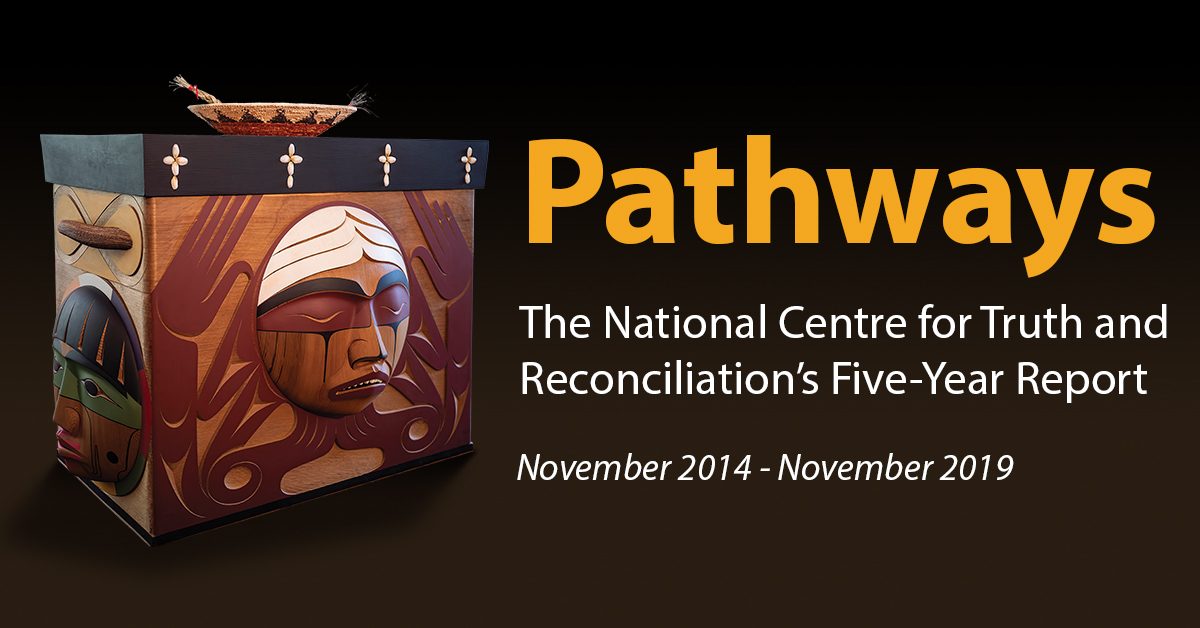
Pathways: The NCTR Five-Year Report
The past year marked a milestone year for the National Centre for Truth and Reconciliation (NCTR). Created in 2014, out of the recommendations of the Truth and Reconciliation Commission of Canada (TRC), the NCTR plays a critical role in preserving the record of the residential school system and honouring the Survivors who bravely shared their stories with the Commission. A five-year report, titled Pathways: The National Centre for Truth and Reconciliation Five-Year Report, November 2014 to November 2019, reflects on the NCTR’s own journey and accomplishments, and is now available to the public.
“Survivors are the reason the NCTR exists,” says director Ry Moran. “It is their records and experiences that the NCTR holds and cares for. It is remarkable how these past five years have shown how these records have informed Reconciliation projects, programs, and healing across the country. We are excited to see how this will continue to grow.”
The Indian Residential Schools Settlement Agreement settled the largest class action lawsuit in the country’s history. This complex agreement created multiple national processes including the Independent Assessment Process (IAP) and the TRC. Learning from lessons of post-TRC implementation challenges around the world, the Canadian TRC was mandated to establish a National Research Centre, the permanent repository for all statements, documents and other materials collected to ensure no one can ever deny what occurred within the residential schools.
“For us, as Survivors, it is important that we see the NCTR as our home, where our truths, experiences and lives are validated, honoured and never forgotten. The staff carry the responsibility – both today and tomorrow – to ensure our voices are carried forward in a good way,” says Eugene Arcand, chair of the Governing Circle.
The NCTR Archives care for over four million archival records made up of more than 15 million digital files. At the heart of the NCTR Archives are the 6,757 Survivor and witness statements that total 44,805 individual files or 2,629 hours of audiovisual content. The Archives also care for more than 1,000 physical objects that were gifted to the TRC during ceremony.
Among the highlights of the past five years of the NCTR are:
- In 2019, the NCTR launched the National Student Memorial Register: an online register which maintains an active list of the children’s names that never returned home from the schools, at a special ceremony, held in Ottawa, that honoured these children.
- The Royal Canadian Geographical Society, in partnership with the Assembly of First Nations, Inuit Tapiriit Kanatami, the Métis National Council, Indspire and the NCTR, developed and launched the first national Indigenous Peoples Atlas.
- The Canadian Advisory Committee for the UNESCO Memory of the World Register accepted the NCTR’s application for inclusion in the Canada Memory of the World Register.
- The NCTR’s Imagine a Canada program has welcomed thousands of submissions from youth across the country, calling upon students to show us their vision of the future of the country through a lens of reconciliation.
- The NCTR has hosted and visited with several international Truth and Reconciliation initiatives, including those from Colombia, Ivory Coast, Mali, Norway, Taiwan, and East-Timor.
The NCTR’s work has been made possible through the generous support of donors and supporters throughout the years. In late 2016, the Government of Canada announced a $10-million operating grant for the NCTR to support seven years of operations. UM also made a five-year commitment to support the NCTR. Together, these two funding sources supply the core operating dollars for the NCTR. TD Bank Group’s contribution of $1 million over 10 years has resulted in a number of important opportunities for students to undertake work at the NCTR and other partner institutions.
Eugene Arcand explains: “While we look back and celebrate the work and experiences shared through the NCTR, we must keep our eyes focused on the future. We shared our pain with the TRC to move this community to a better place – to ensure no child, of today or tomorrow, has to endure what we went through. However, we recognize that the harms of colonialism still visit our children and communities today, just wearing a different mask.”







I am a Mi’kmaq INDIGENOUS student Support worker, I would like to pass on this information to the students that I work with